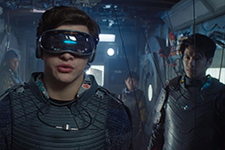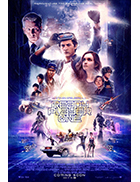Ready Player One
|  During the first half of his career, Steven Spielberg was so widely and unproblematically understood as a mass commercial entertainer that, when he did venture into more “serious” depths with films like The Color Purple (1985) and Empire of the Sun (1987), it was seen as shocking—shocking!, I tell you—if not an outright violation of some nonexistent contract the audience assumed it had with the director. After all, surely the man who gave us Jaws (1975) and Raiders of the Lost Ark (1981) and E.T. The Extra-Terrestrial (1982) was not allowed to make films about patriarchal violence, racism, and war (such a view, of course, requires us to see Spielberg’s popular films as nothing more than simple, conventional, feel-good entertainments with no depth or artistry, a perspective I wrote an entire book to refute). Ever since Spielberg took home an armful of Oscars for his powerful Holocaust drama Schindler’s List (1993), he has been allowed to wear the label of “serious” filmmaker. Since then, he has embraced that role, to the point that now the dichotomy has been flipped: He so often makes more serious-minded (usually historical) films, that when he does turn out a grand entertainment, it feels like an anomaly. Of the six films he has made since 2010, four have been historical dramas—War Horse (2011), Lincoln (2012), Bridge of Spies (2015), and The Post (2017)—while only two—The Adventures of Tintin (2011) and The BFG (2016)—have been fantasy adventures. The fact that both of those films were box-office and critical disappointments suggests that perhaps Spielberg has reached a point of no return in his career, having invested himself so deeply in being the cinematic narrator of American history that he has lost the touch that defined the first half of his career when he could turn stories about sharks and UFOs and swashbuckling archaeologists and dumpy aliens into box-office gold. Into this conundrum roars Ready Player One, as overt an attempt as Spielberg has made in years to reclaim his mastery of fantastical escapism. Based on the best-selling first novel by Ernest Cline, the story is set in the dystopian near future of 2045, where people regularly leave the grind of real life behind and enter the OASIS, a massive, completely immersive virtual reality world. In the OASIS, anyone can be anything, and its depth and breadth are both limitless. The creator of the OASIS, James Halliday (Mark Rylance), was a brilliant eccentric obsessed with the popular culture of his late 1970s and ’80s childhood, which just happens to correspond with the initial heyday of Spielberg’s career as mass entertainer par excellence (not surprisingly, Spielberg is mentioned directly in Cline’s novel). When Halliday dies, his estate reveals that he buried an Easter egg deep inside the OASIS, and whoever manages to find it via three hidden keys will inherit his multi-billions dollar estate and, more importantly, complete control of the OASIS. The film’s protagonist is Wade Watts, an introverted high school student who lives in Columbus, Ohio, in a ghetto-neighborhood known as “the Stacks,” so named because it is composed of literal stacks of mobile homes. He escapes his abusive home environment by regularly immersing himself in the OASIS, where he takes on a sleek-haired, K-pop-style avatar called Parzival. His best friend within the OASIS (who he has never met in real life) is Aech (Lena Waithe), whose avatar is a massive, hulking mechanic. Within the OASIS Wade is known as a “gunter,” which is short for “egg hunter,” meaning that he spends most of his time trying to track down the three hidden keys that will lead to Halliday’s Easter egg. The starting point of this search is a massive road race that gives us our first real immersion into the story’s seemingly limitless evocation of Reagan-era popular culture, with Parzival ripping through the race in the time-machine DeLorean made famous in Back to the Future (1985)—which Spielberg executive-produced—driving through the legs of Jurassic Park’s roaring Tyrannosaurus Rex and being chased, along with other familiar-from-the-movies vehicles like Mad Max’s V8 Interceptor and the campy 1966 Batmobile, by none other than King Kong. It is during this race that Wade/Parzival first crosses paths with Art3mis (Olivia Cooke), another grunter, albeit one with a more pressing mission. Claiming to be part of an underground resistance, Art3mis is determined to solve the puzzles and find the Easter egg to keep it out of the hands of Innovative Online Industries (IOI), a nefarious mega-corporation headed by Nolan Sorrento (Ben Mendelsohn), a Halliday protégé gone bad. Sorrento employs hundreds of professional gamers within the OASIS, as well as seasoned research teams dedicated to mining Halliday’s well-preserved memories for his pop culture obsessions with the idea that some of that information might be key to unlocking the location of the Easter egg. Wade/Parzival is a whiz himself in all things Halliday, and he eventually teams with Art3mis, Aech, and several others in a joint quest to claim the OASIS for themselves. Much of the film takes place within the virtual world, which is constructed entirely of computer-generated imagery that is quite often breathtaking in its visual depth and detail. Spielberg previously ventured into the fully virtual cinematic world with his Peter Jackson-produced Tintin adventure, a foray that lured him into a hyperkinetic aesthetic that eventually proved exhausting. Something similar happens in the early sequences of Ready Player One, particularly the aforementioned road race, which, freed from the laws of physics and the need for a physical camera, becomes a hectic, freewheeling, action free-for-all that, at its worst, ventures into Michael Bay-style incoherence combined with a desire to hammer us at every turn with the film’s hyperkinetic ’80s gestalt. Spielberg is too good of a director to completely lose the film in this manner, but he flirts with disaster here, jettisoning the keen sense of spatial relations and physicality that defined his best action sequences (including the fabulous USO dance sequence in his unfairly maligned 1979 comedy spectacular 1941) in favor of a gee-whiz anything-goes aesthetic that abuses the film’s premise as a built-in excuse. Thankfully, the film improves as it goes on, especially in the second half, where Spielberg generates a successful tension in juxtaposing action taking place simultaneously within the real world and the OASIS. He also pulls off a genuinely impressive sequence midway through the film that takes place entirely within the world of a very well-known movie that might just constitute the best sustained movie in-joke in cinematic history (some cinema snobs will surely loathe it, but no surprise there). The danger, of course, is that Ready Player One might become little more than the sum of its pop-culture references, which are voluminous, to say the least (aficionados are already spending copious amounts of time assembling lists of the film’s myriad references, both substantial and blink-and-you-miss-’em). The screenplay by Zack Penn, a veteran of numerous Marvel movies including The Avengers (2012), and Cline takes some substantial liberties with the novel, at least partially due to licensing issues, but it maintains a relatively thoughtful stance regarding the dangers of immersing oneself too deeply in fantasy worlds as escape from the real one. The OASIS is the ultimate escape, a place where one can be whatever one wants to be, which has always been the ultimate meat-shedding dream of cyberculture. The film features a coda that is clearly meant to mark it as a cautionary tale, yet you can’t deny that the story works at least partially because of the relationships forged within the virtual reality. Parzival and Aech are best friends even though they have never shared physical space, and Parzival starts falling in love with Art3mis long before he meets her in the flesh (it is telling, though, that the real romance flourishes in the real world). Unfortunately, Wade is not the most compelling protagonist, and Ready Player One stumbles to some extent because his journey is largely functional and lacks an emotionally compelling edge. That edge, however, is not completely lost, as the film’s final act finds its real emotional core in Halliday, the story’s central enigma who own backstory and reasoning for creating the OASIS turn out to have a deep and surprising poignancy that Mark Rylance conveys with a beautiful simplicity. Far from an ultra-geek cartoon, his Halliday turns out to be Ready Player One’s beating heart of humanity. Copyright © 2018 James Kendrick Thoughts? E-mail James Kendrick All images copyright © Warner Bros. |
Overall Rating: 

 (3)
(3)


